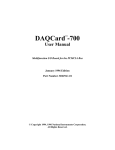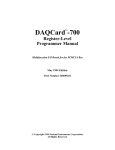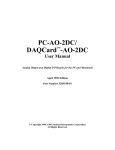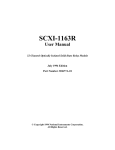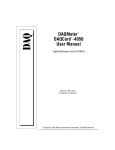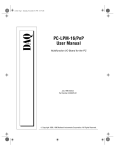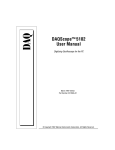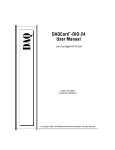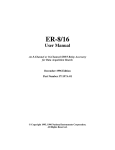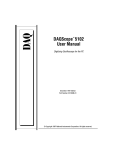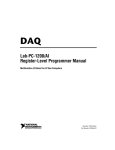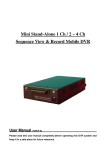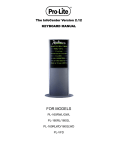Download DAQCard-500 User Manual
Transcript
™ DAQCard -500 User Manual Multifunction I/O Card for Type II PCMCIA Bus January 1996 Edition Part Number 371918A-01 © Copyright 1995, 1996 National Instruments Corporation. All Rights Reserved. National Instruments Corporate Headquarters 6504 Bridge Point Parkway Austin, TX 78730-5039 (512) 794-0100 Technical support fax: (800) 328-2203 (512) 794-5678 Branch Offices: Australia 03 9 879 9422, Austria 0662 45 79 90 0, Belgium 02 757 00 20, Canada (Ontario) 519 622 9310, Canada (Québec) 514 694 8521, Denmark 45 76 26 00, Finland 90 527 2321, France 1 48 14 24 24, Germany 089 741 31 30, Hong Kong 2645 3186, Italy 02 48301892, Japan 03 5472 2970, Korea 02 596 7456, Mexico 95 800 010 0793, Netherlands 0348 433466, Norway 32 84 84 00, Singapore 2265886, Spain 91 640 0085, Sweden 08 730 49 70, Switzerland 056 200 51 51, Taiwan 02 377 1200, U.K. 01635 523545 Limited Warranty The DAQCard-500 is warranted against defects in materials and workmanship for a period of one year from the date of shipment, as evidenced by receipts or other documentation. National Instruments will, at its option, repair or replace equipment that proves to be defective during the warranty period. This warranty includes parts and labor. The media on which you receive National Instruments software are warranted not to fail to execute programming instructions, due to defects in materials and workmanship, for a period of 90 days from date of shipment, as evidenced by receipts or other documentation. National Instruments will, at its option, repair or replace software media that do not execute programming instructions if National Instruments receives notice of such defects during the warranty period. National Instruments does not warrant that the operation of the software shall be uninterrupted or error free. A Return Material Authorization (RMA) number must be obtained from the factory and clearly marked on the outside of the package before any equipment will be accepted for warranty work. National Instruments will pay the shipping costs of returning to the owner parts which are covered by warranty. National Instruments believes that the information in this manual is accurate. The document has been carefully reviewed for technical accuracy. In the event that technical or typographical errors exist, National Instruments reserves the right to make changes to subsequent editions of this document without prior notice to holders of this edition. The reader should consult National Instruments if errors are suspected. In no event shall National Instruments be liable for any damages arising out of or related to this document or the information contained in it. EXCEPT AS SPECIFIED HEREIN, NATIONAL INSTRUMENTS MAKES NO WARRANTIES, EXPRESS OR IMPLIED, AND SPECIFICALLY DISCLAIMS ANY WARRANTY OF MERCHANTABILITY OR FITNESS FOR A PARTICULAR PURPOSE . CUSTOMER’S RIGHT TO RECOVER DAMAGES CAUSED BY FAULT OR NEGLIGENCE ON THE PART OF NATIONAL INSTRUMENTS SHALL BE LIMITED TO THE AMOUNT THERETOFORE PAID BY THE CUSTOMER. NATIONAL INSTRUMENTS WILL NOT BE LIABLE FOR DAMAGES RESULTING FROM LOSS OF DATA, PROFITS, USE OF PRODUCTS, OR INCIDENTAL OR CONSEQUENTIAL DAMAGES, EVEN IF ADVISED OF THE POSSIBILITY THEREOF. This limitation of the liability of National Instruments will apply regardless of the form of action, whether in contract or tort, including negligence. Any action against National Instruments must be brought within one year after the cause of action accrues. National Instruments shall not be liable for any delay in performance due to causes beyond its reasonable control. The warranty provided herein does not cover damages, defects, malfunctions, or service failures caused by owner’s failure to follow the National Instruments installation, operation, or maintenance instructions; owner’s modification of the product; owner’s abuse, misuse, or negligent acts; and power failure or surges, fire, flood, accident, actions of third parties, or other events outside reasonable control. Copyright Under the copyright laws, this publication may not be reproduced or transmitted in any form, electronic or mechanical, including photocopying, recording, storing in an information retrieval system, or translating, in whole or in part, without the prior written consent of National Instruments Corporation. Trademarks LabVIEW ®, NI-DAQ ®, RTSI ®, and DAQCard ™ are trademarks of National Instruments Corporation. Product and company names listed are trademarks or trade names of their respective companies. WARNING REGARDING MEDICAL AND CLINICAL USE OF NATIONAL INSTRUMENTS PRODUCTS National Instruments products are not designed with components and testing intended to ensure a level of reliability suitable for use in treatment and diagnosis of humans. Applications of National Instruments products involving medical or clinical treatment can create a potential for accidental injury caused by product failure, or by errors on the part of the user or application designer. Any use or application of National Instruments products for or involving medical or clinical treatment must be performed by properly trained and qualified medical personnel, and all traditional medical safeguards, equipment, and procedures that are appropriate in the particular situation to prevent serious injury or death should always continue to be used when National Instruments products are being used. National Instruments products are NOT intended to be a substitute for any form of established process, procedure, or equipment used to monitor or safeguard human health and safety in medical or clinical treatment. Contents ____________________________________________________ About This Manual............................................................................................................. ix Organization of This Manual ......................................................................................... ix Conventions Used in This Manual................................................................................. x National Instruments Documentation ........................................................................... x Related Documentation.................................................................................................. xi Customer Communication ............................................................................................. xi Chapter 1 Introduction .......................................................................................................................... 1-1 About the DAQCard-500............................................................................................... 1-1 What You Need to Get Started ...................................................................................... 1-2 Software Programming Choices .................................................................................... 1-2 LabVIEW and LabWindows/CVI Application Software .................................. 1-2 NI-DAQ Driver Software................................................................................... 1-3 Register-Level Programming............................................................................. 1-4 Optional Equipment ....................................................................................................... 1-4 Unpacking ...................................................................................................................... 1-4 Chapter 2 Installation and Configuration....................................................................................... 2-1 Installation...................................................................................................................... 2-1 Configuration ................................................................................................................. 2-2 Analog Input Configuration...............................................................................2-3 Digital I/O Configuration...................................................................................2-3 Counter Configuration .......................................................................................2-3 Chapter 3 Signal Connections ............................................................................................................. 3-1 I/O Connector................................................................................................................. 3-1 Signal Connection Descriptions..................................................................................... 3-2 Analog Input Signal Connections ...................................................................... 3-2 Analog Input Signal Connection Considerations...................................3-3 Types of Signal Sources.........................................................................3-3 Ground-Referenced Signal Sources...........................................3-3 Floating Signal Sources .............................................................3-3 Types of Measurement Systems ............................................................3-3 Ground-Referenced Measurement System ................................3-4 Floating Measurement System...................................................3-4 Analog Input Configurations .................................................................3-4 Digital I/O Signal Connections..........................................................................3-5 Timing Connections...........................................................................................3-7 Data Acquisition Counter and Timing Connections..............................3-7 General-Purpose Counter and Timing Signal Connections ...................3-7 Cabling...........................................................................................................................3-11 © National Instruments Corporation v DAQCard-500 User Manual Contents Chapter 4 Theory of Operation .......................................................................................................... 4-1 Functional Overview......................................................................................................4-1 PCMCIA I/O Channel Interface Circuitry.....................................................................4-2 Analog Input and Data Acquisition Circuitry................................................................4-3 Analog Input Circuitry.......................................................................................4-3 Data Acquisition Timing Circuitry ....................................................................4-4 Single-Channel Data Acquisition...........................................................4-4 Multichannel (Scanned) Data Acquisition.............................................4-5 Data Acquisition Rates...........................................................................4-5 Digital I/O Circuitry.......................................................................................................4-5 Timing I/O Circuitry ......................................................................................................4-6 Appendix A Specifications ........................................................................................................................ A-1 Appendix B Differences between the DAQCard-700 and the DAQCard-500 ....................... B-1 Appendix C Custom Cable Design......................................................................................................... C-1 Appendix D PC Card Questions and Answers .................................................................................. D-1 Appendix E Power Management Modes ............................................................................................. E-1 Appendix F PSH27-50F Signal Connections ..................................................................................... F-1 Appendix G Customer Communication............................................................................................... G-1 Glossary ......................................................................................................................Glossary-1 Index ................................................................................................................................. Index-1 DAQCard-500 User Manual vi © National Instruments Corporation Contents Figures Figure 1-1. The Relationship between the Programming Environment, NI-DAQ, and Your Hardware.............................................................................................. 1-3 Figure 2-1. A Typical Configuration for the DAQCard-500 ................................................ 2-2 Figure 3-1. Figure 3-2. Figure 3-3. Figure 3-4. Figure 3-5. Figure 3-6. Figure 3-7. I/O Connector Pin Assignments .......................................................................... 3-1 DAQCard-500 Analog Input Connections .......................................................... 3-5 Digital I/O Signal Connections............................................................................ 3-6 EXTCONV* Signal Timing ................................................................................ 3-7 Event-Counting Applications with External Switch Gating................................ 3-8 Frequency Measurement Application.................................................................. 3-9 General-Purpose Timing Signals......................................................................... 3-10 Figure 4-1. Figure 4-2. Figure 4-3. Figure 4-4. Figure 4-5. Figure 4-6. DAQCard-500 Block Diagram............................................................................ 4-1 PCMCIA I/O Interface Circuitry Block Diagram ............................................... 4-2 Analog Input and Data Acquisition Circuitry Block Diagram ............................ 4-3 Digital I/O Circuitry Block Diagram................................................................... 4-6 Timing I/O Circuitry Block Diagram .................................................................. 4-7 Counter Block Diagram....................................................................................... 4-7 Figure C-1. DAQCard-500 I/O Connector Pin Assignments.................................................. C-2 Figure F-1. CB-50 Pin Assignments Using the PSH27-50F-D1 Cable.................................. F-1 Tables Table 3-1. Recommended Input Configurations for Ground-Referenced and Floating Measurement Systems...........................................................................3-4 Table E-1. DAQCard-500 Power-Management Modes.........................................................E-1 © National Instruments Corporation vii DAQCard-500 User Manual About This Manual This manual describes the mechanical and electrical aspects of the DAQCard-500 and contains information concerning its installation and operation. The DAQCard-500 is a compact, low-cost, low-power analog input, digital I/O, and timing I/O board for computers that are equipped with a Type II PCMCIA socket. Organization of This Manual The DAQCard-500 User Manual is organized as follows: • Chapter 1, Introduction, describes the DAQCard-500, lists what you need to get started, your software programming choices, and explains how to unpack the DAQCard-500. • Chapter 2, Installation and Configuration, describes how to install and software configure the DAQCard-500. • Chapter 3, Signal Connections, describes the signals on the PR27-30F I/O connector and the CB-27 connector block, optional accessories available from National Instruments. • Chapter 4, Theory of Operation, includes an overview of the DAQCard-500 and explains the operation of each functional unit making up the DAQCard-500. • Appendix A, Specifications, lists the specifications of the DAQCard-500. • Appendix B, Differences between the DAQCard-700 and the DAQCard-500, contains a summary of differences between the DAQCard-700 and the DAQCard-500 that may be relevant to you if you are a current DAQCard-700 user. • Appendix C, Custom Cable Design, describes the pin connections on the DAQCard-500, which you will need to use only if you are designing your own cable. • Appendix D, PC Card Questions and Answers, contains a list of common questions and answers relating to PC Card (PCMCIA) operation. • Appendix E, Power-Management Modes, describes the power-management modes of the DAQCard-500. • Appendix F, PSH27-50F Signal Connections, gives the pin assignments for the CB-50 I/O connector block when using the PSH27-50F-D1 cable with the DAQCard-500. • Appendix G, Customer Communication, contains forms you can use to request help from National Instruments or to comment on our products. • The Glossary contains an alphabetical list and description of terms used in this manual, including acronyms, abbreviations, metric prefixes, mnemonics, and symbols. • The Index alphabetically lists topics covered in this manual, including the page number where you can find the topic. Conventions Used in This Manual The following conventions are used in this manual: © National Instruments Corporation ix DAQCard-500 User Manual About This Manual bold italic Bold italic text denotes a note, caution, or warning. italic Italic text denotes emphasis, a cross reference, or an introduction to a key concept. NI-DAQ NI-DAQ refers to the NI-DAQ software. <> Angle brackets, < >, containing numbers separated by an ellipsis represent a range of values associated with a bit or signal name (for example, ACH<0..7> stands for the signals ACH0 through ACH7). Abbreviations, acronyms, metric prefixes, mnemonics, symbols, and terms are listed in the Glossary. National Instruments Documentation The DAQCard-500 User Manual is one piece of the documentation set for your data acquisition system. You could have any of several types of manuals, depending on the hardware and software in your system. Use the manuals you have as follows: • Getting Started with SCXI—If you are using SCXI, this is the first manual you should read. It gives an overview of the SCXI system and contains the most commonly needed information for the modules, chassis, and software. • Your SCXI user manuals—If you are using SCXI, read these manuals next for detailed information about signal connections and module configuration. They also explain in greater detail how the module works and contain application hints. • Your DAQ hardware user manuals—These manuals have detailed information about the DAQ hardware that plugs into or is connected to your computer. Use these manuals for hardware installation and configuration instructions, specification information about your DAQ hardware, and application hints. • Software documentation—Examples of software documentation you may have are the LabVIEW and LabWindows/CVI manual sets and the NI-DAQ documentation. After you set up your hardware system, use either the application software (LabVIEW or LabWindows/CVI) manuals or the NI-DAQ documentation to help you write your application. If you have a large and complicated system, it is worthwhile to look through the software documentation before you configure your hardware. DAQCard-500 User Manual x © National Instruments Corporation About This Manual • Accessory manuals—If you are using accessory products, read the terminal block and cable assembly installation guides. They explain how to physically connect the relevant pieces of the system. Consult these guides when you are making your connections. • SCXI chassis manuals—If you are using SCXI, read these manuals for maintenance information on the chassis, installation instructions, and information about making custom modules. Related Documentation The following documents contain information that you may find helpful as you read this manual: • Your NI-DAQ software documentation • Your computer operating manual, which explains how to insert cards into the PCMCIA slot The following National Instruments manual contains detailed information for the register-level programmer: • DAQCard-500 Register-Level Programmer Manual This manual is available from National Instruments by request. If you are using NI-DAQ, LabVIEW, or LabWindows/CVI, you should not need the register-level programmer manual. Using NI-DAQ, LabVIEW, or LabWindows/CVI is as easy and as flexible as using the low-level programming described in the register-level programmer manual. Refer to Software Programming Choices in Chapter 1, Introduction, of this manual to learn more about your programming options. Customer Communication National Instruments wants to receive your comments on our products and manuals. We are interested in the applications you develop with our products, and we want to help if you have problems with them. To make it easy for you to contact us, this manual contains comment and configuration forms for you to complete. These forms are in Appendix G, Customer Communication, at the end of this manual. © National Instruments Corporation xi DAQCard-500 User Manual Chapter 1 Introduction This chapter describes the DAQCard-500, lists what you need to get started, your software programming choices, and explains how to unpack the DAQCard-500. About the DAQCard-500 Thank you for purchasing the National Instruments DAQCard-500. The DAQCard-500 is a lowcost, low-power analog input, digital I/O, and timing I/O board for computers equipped with a Type II PCMCIA slot. The board contains a 12-bit, successive-approximation ADC with eight single-ended analog inputs, four lines of TTL-compatible digital input, and four lines of digital output. The optional 27-pin I/O connector for the DAQCard-500 enables you to easily connect all your signals directly to the card. The DAQCard-500 is fully software configurable and calibrated so that you can easily install the card and begin your acquisition without having to spend time calibrating the card. The DAQCard-500 ships with NI-DAQ, National Instruments’ complete DAQ driver that handles every function listed on the data sheet for our DAQ hardware. Using NI-DAQ you can quickly and easily start your application without having to program the card on the register level. The small size and weight of the DAQCard-500 coupled with its low-power consumption make this board ideal for use in portable computers, making remote data acquisition practical. The board requires very little power when operating and has a standby mode that uses even less power, thus extending the life of your computer batteries. In addition, the low cost of a system based on the DAQCard-500 makes it ideal for laboratory work in industrial and academic environments. The multichannel analog input is useful in signal analysis and data logging. The 12-bit ADC is useful in high-resolution applications such as chromatography, temperature measurement, and DC voltage measurement. The eight TTLcompatible digital I/O lines can be used for switching external devices such as transistors and solid-state relays, and for reading the status of external digital logic. The DAQCard-500, used in conjunction with your computer, is a versatile, cost-effective platform for laboratory test, measurement, and control. Detailed specifications for the DAQCard-500 are in Appendix A, Specifications. © National Instruments Corporation 1-1 DAQCard-500 User Manual Introduction Chapter 1 What You Need to Get Started To set up and use your DAQCard-500, you will need the following: DAQCard-500 PR27-30F I/O connector with cable (must be purchased separately) DAQCard-500 User Manual One of the following software packages and documentation: NI-DAQ for PC compatibles NI-DAQ for NEC PC-9800 Series NI-DAQ for Macintosh LabVIEW for Windows LabWindows/CVI for Windows Your computer Software Programming Choices There are several options to choose from when programming your National Instruments DAQ and SCXI hardware. You can use LabVIEW, LabWindows/CVI, or NI-DAQ. LabVIEW and LabWindows/CVI Application Software LabVIEW and LabWindows/CVI are innovative program development software packages for data acquisition and control applications. LabVIEW uses graphical programming, whereas LabWindows/CVI enhances traditional programming languages. Both packages include extensive libraries for data acquisition, instrument control, data analysis, and graphical data presentation. LabVIEW features interactive graphics, a state-of-the-art user interface, and a powerful graphical programming language. The LabVIEW Data Acquisition VI Library, a series of VIs for using LabVIEW with National Instruments DAQ hardware, is included with LabVIEW. The LabVIEW Data Acquisition VI Libraries are functionally equivalent to the NI-DAQ software. LabWindows/CVI features interactive graphics, a state-of-the-art user interface, and uses the ANSI standard C programming language. The LabWindows/CVI Data Acquisition Library, a series of functions for using LabWindows/CVI with National Instruments DAQ hardware, is included with the NI-DAQ software kit. The LabWindows/CVI Data Acquisition libraries are functionally equivalent to the NI-DAQ software. Using LabVIEW or LabWindows/CVI software will greatly reduce the development time for your data acquisition and control application. DAQCard-500 User Manual 1-2 © National Instruments Corporation Chapter 1 Introduction NI-DAQ Driver Software The NI-DAQ driver software is included at no charge with all National Instruments DAQ hardware. NI-DAQ is not packaged with SCXI or accessory products, except for the SCXI-1200. NI-DAQ has an extensive library of functions that you can call from your application programming environment. These functions include routines for analog input (A/D conversion), buffered data acquisition (high-speed A/D conversion), analog output (D/A conversion), waveform generation, digital I/O, counter/timer operations, SCXI, RTSI, self-calibration, messaging, and acquiring data to extended memory. NI-DAQ has both high-level DAQ I/O functions for maximum ease of use and low-level DAQ I/O functions for maximum flexibility and performance. Examples of high-level functions are streaming data to disk or acquiring a certain number of data points. An example of a low-level function is writing directly to registers on the DAQ device. NI-DAQ does not sacrifice the performance of National Instruments DAQ devices because it lets multiple devices operate at their peak performance. NI-DAQ also internally addresses many of the complex issues between the computer and the DAQ hardware such as programming interrupts and DMA controllers. NI-DAQ maintains a consistent software interface among its different versions so that you can change platforms with minimal modifications to your code. Figure 1-1 illustrates the relationship between NI-DAQ and LabVIEW and LabWindows/CVI. Conventional Programming Environment (PC, Macintosh, or Sun SPARCstation) LabVIEW (PC, Macintosh, or Sun SPARCstation) LabWindows/CVI (PC or Sun SPARCstation) NI-DAQ Driver Software Personal Computer or Workstation DAQ or SCXI Hardware Figure 1-1. The Relationship between the Programming Environment, NI-DAQ, and Your Hardware © National Instruments Corporation 1-3 DAQCard-500 User Manual Introduction Chapter 1 Register-Level Programming The final option for programming any National Instruments DAQ hardware is to write registerlevel software. Writing register-level programming software can be very time-consuming and inefficient and is not recommended for most users. Even if you are an experienced register-level programmer, consider using NI-DAQ, LabVIEW, or LabWindows/CVI to program your National Instruments DAQ hardware. Using the NI-DAQ, LabVIEW, or LabWindows/CVI software is as easy and as flexible as register-level programming and can save weeks of development time. Optional Equipment Listed below are some of the optional accessories that work with the DAQCard-500. New accessories are always being added to our product family. See your National Instruments catalog or call the National Instruments office nearest you for more information about optional equipment. • PR27-30F I/O connector with .5 m or 1 m connector cable • CB-27 I/O connector block Unpacking The DAQCard-500 is shipped in an antistatic vinyl case; when you are not using the DAQCard-500, you should store it in this case. Because the DAQCard-500 is enclosed in a fully shielded case, no additional electrostatic precautions are necessary. However, for your own safety and to protect the DAQCard-500, never attempt to touch the pins of the connectors. DAQCard-500 User Manual 1-4 © National Instruments Corporation Chapter 2 Installation and Configuration This chapter describes how to install and software configure the DAQCard-500. Installation Your computer should be equipped with Card and Socket Services 2.0 or later. The DAQCard-500 requires a 32-byte I/O address window and one interrupt level. This manual assumes that you are using the optional PR27-30F cable from National Instruments. Notice that the cable is keyed so that you can insert it only one way. Insert the DAQCard-500 and attach the I/O cable. Your DAQCard-500 kit includes a label for the CB-27 terminal block, which is available from National Instruments. If you are using the CB-27, attach the label to the inside cover. This label identifies the DAQCard-500 signal connections for the CB-27. The DAQCard-500 has two connectors–a 68-pin PCMCIA bus connector on one end and a 27-pin I/O connector on the other end. Insert the PCMCIA bus connector into any available Type II PCMCIA slot until the connector is seated firmly. Notice that the card is keyed so that it can be inserted only one way. If your computer supports hot insertion, you may insert or remove the DAQCard-500 at any time, whether your computer is powered on or off. Be very careful not to put strain on the I/O cable when inserting it into and removing it from the DAQCard-500. Always grasp the cable by the connector you are plugging or unplugging. Never pull directly on the I/O cable to unplug it from the DAQCard-500. Figure 2-1 shows an example of a typical configuration. © National Instruments Corporation 2-1 DAQCard-500 User Manual Installation and Configuration Chapter 2 Portable Computer PCMCIA Socket RD CA Q DA RT SE IN 0 50 “- rd Ca PR27-30F CB-27 7 -2 CB Figure 2-1. A Typical Configuration for the DAQCard-500 The DAQCard-500 is now installed. You are ready to make the appropriate connections to the I/O connector cable as described in Chapter 3, Signal Connections, and to install and configure your software. Configuration The DAQCard-500 is completely software configurable; refer to your software documentation to install and configure the software. If you are using NI-DAQ for PC compatibles or NI-DAQ for NEC PC-9800 Series computers, refer to your NI-DAQ release notes. Find the installation and system configuration section for your operating system and follow the instructions given there. If you are using NI-DAQ for Macintosh, refer to the NI-DAQ documentation. Find the installation and system configuration section for your operating system and follow the instructions given there. If you are using LabVIEW, the software installation instructions are in your LabVIEW release notes. After you have installed LabVIEW, refer to the Configuring LabVIEW section of Chapter 1 of your LabVIEW user manual for software configuration instructions. DAQCard-500 User Manual 2-2 © National Instruments Corporation Chapter 2 Installation and Configuration If you are using LabWindows/CVI, the software installation instructions are in Part 1, Introduction to LabWindows/CVI, of the Getting Started with LabWindows/CVI manual. After you have installed LabWindows/CVI, refer to Chapter 1, Configuring LabWindows/CVI, of the LabWindows/CVI User Manual for software configuration instructions. If you are a register-level programmer, refer to the DAQCard-500 Register-Level Programmer Manual. Analog Input Configuration The DAQCard-500 is always configured as follows: • Single-ended input mode referenced to analog ground • ±5 V analog input range Digital I/O Configuration The DAQCard-500 always uses one 4-bit digital output port and one 4-bit digital input port. Counter Configuration You can use the MSM82C54 counter/timers for general-purpose applications, such as pulse and square wave generation, event counting, and pulsewidth, time-lapse, and frequency measurement. For information about configuring the MSM82C54, see the Timing Connections section of Chapter 3, Signal Connections. © National Instruments Corporation 2-3 DAQCard-500 User Manual Chapter 3 Signal Connections This chapter describes the signals on the PR27-30F I/O connector and the CB-27 connector block, optional accessories available from National Instruments. Appendix C, Custom Cable Design, contains information and guidelines for the design of custom cables. Appendix F, PSH27-50F Signal Connections, contains information for using the the PSH27-50F and the CB-50 connector block, optional accessories available from National Instruments. I/O Connectors Figure 3-1 shows the pin assignments for the PR27-30F I/O connector and CB-27 connector block. Although the pin arrangements on these connectors differ, notice that the signal names and pin numbers are the same. Warning: Connections that exceed any of the maximum ratings of input or output signals on the DAQCard-500 can damage the DAQCard-500 and your computer. This includes connecting any power signals to ground and vice versa. National Instruments is NOT liable for any damages resulting from such signal connections. 13 27 DGND ACH0 2 1 AIGND DIN0 12 26 OUT2 ACH2 4 3 ACH1 EXTCONV* 11 25 CLK2 ACH4 6 5 ACH3 +5 V 10 24 GATE2 ACH6 8 7 ACH5 ACH7 9 23 OUT1 +5 V 10 9 ACH7 ACH6 8 22 CLK1 DIN0 12 11 EXTCONV* ACH5 7 21 DGND DIN2 14 13 DIN1 ACH4 6 20 1 MHz DOUT0 16 15 ACH3 5 19 DOUT3 DOUT2 18 17 DOUT1 ACH2 4 18 DOUT2 1MHz 20 19 DOUT3 ACH1 3 17 DOUT1 CLK1 22 21 DGND ACH0 2 16 DOUT0 GATE2 24 23 OUT1 AIGND 1 15 DIN3 OUT2 26 25 CLK2 AIGND 1 14 DIN2 NC 28 27 DGND NC 30 29 NC key DIN1 DIN3 b. PR27-30F Cable a. CB-27 Connector Block Figure 3-1. I/O Connector Pin Assignments © National Instruments Corporation 3-1 DAQCard-500 User Manual Signal Connections Chapter 3 Signal Connection Descriptions Pin Signal Name Description 1 AIGND Analog Input Ground—This signal is the common ground tie-in point for all analog signals. 2–9 ACH<0..7> Analog Input Channels 0 through 7—These signals are the single-ended analog input signals. 10 +5 V +5 Volts—This pin provides +5 VDC. The +5 V supply is fused at 1 A, which is the maximum current available. 11 EXTCONV* External Convert Signal—This input signal externally initiates an A/D conversion. 12–15 DIN<0..3> Digital Input Data Lines—These signals are TTL-compatible, digital input lines. DIN3 is the MSB; DIN0 is the LSB 16–19 DOUT<0..3> Digital Output Data Lines—These signals are TTL-compatible digital output lines. DOUT3 is the MSB; DOUT0 is the LSB. 20 1 MHz 1 MHz Square Wave Output of Oscillator—This signal is a 1 MHz square wave for use with the internal counter or external timing needs. 21, 27 DGND Digital Ground—This is the common ground tie-in point for all digital signals. 22 CLK1 Clock Input of Counter 1—This signal is the clock input of counter 1. 23 OUT1 Output of Counter 1—This signal outputs the programmed waveform of counter 1. 24 GATE2 Gate Input of Counter 2—This signal controls the starting, interruption, and restarting of counter 2. 25 CLK2 Clock Input of Counter 2—This signal is the clock input of counter 2. 26 OUT2 Output of Counter 2—This signal outputs the programmed waveform of counter 2. 28–30 NC Not Connected—These signals are not connected. Note: An asterisk (*) indicates that the signal is active low. The connector pins are grouped into analog input signal pins, digital I/O signal pins, and timing I/O signal pins. Signal connection guidelines for each of these groups are included in the following pages. Analog Input Signal Connections Pins 1 through 9 are analog input signal pins for the ADC. Pin 1, AIGND, is an analog common signal. You can use these pins for a general analog power ground tie to the DAQCard-500. Pins 2 through 9 are the ACH<0..7> signal pins. These pins are tied to the analog input channels of the DAQCard-500 through 4.7 k series resistors. These resistors limit the input current DAQCard-500 User Manual 3-2 © National Instruments Corporation Chapter 3 Signal Connections to the multiplexer. The following input range and maximum ratings apply to inputs ACH<0..7>: • Input signal range ±5 V • Maximum input voltage rating ±25 V powered on or off Warning: Exceeding the input signal range distorts input signals. Exceeding the maximum input voltage rating may damage the DAQCard-500 card and the computer. National Instruments is NOT liable for any damages resulting from any such signal connections. Analog Input Signal Connection Considerations When making analog signal connections to the DAQCard-500, you should first determine whether the signal source and the measurement system are floating or ground referenced. The two types of signal sources are described as follows, and the types of measurement systems are described in later sections. Types of Signal Sources Ground-Referenced Signal Sources A ground-referenced signal source is one that is connected in some way to the building system ground. Nonisolated outputs of instruments and devices that plug into the building power system fall into this category. The difference in ground potential between two instruments connected to the same building power system is typically between 1 and 100 mV but can be much higher if power distribution circuits are not properly connected. Floating Signal Sources A floating signal source is one that is not connected in any way to the building ground system but rather has an isolated ground-reference point. Some examples of floating signal sources are outputs of transformers, thermocouples, battery-powered devices, optical isolator outputs, and isolation amplifiers. The ground reference of a floating signal must be tied to the DAQCard-500 analog input ground to establish a local or onboard reference for the signal. Otherwise, the measured input signal varies or appears to float. An instrument or device that provides an isolated output falls into the floating signal source category. Types of Measurement Systems In addition to determining the type of signal source, you also need to determine whether your measurement system is floating or ground referenced. These two types of measurement systems © National Instruments Corporation 3-3 DAQCard-500 User Manual Signal Connections Chapter 3 are described below. Depending on the power connection, a portable computer can represent either a floating or ground-referenced measurement system. If a portable computer is entirely battery powered, it is a floating system. If it is operated from an AC/DC wall adapter, it may or may not be ground referenced, depending on the connection. You should determine from your computer documentation whether any of the power connections are tied to the building power system ground. Ground-Referenced Measurement System A ground-referenced measurement system is one that is connected in some way to the building system ground. Instruments that plug into the building power system fall into this category. Floating Measurement System A floating measurement system is one that is not connected in any way to the building ground system but rather has an isolated ground-reference point. Some examples of floating measurement systems are battery-powered instruments, instruments powered with a nongroundreferenced power adapter, and instruments with differential inputs. A floating measurement system will float to the level of the signals being measured. Analog Input Connections The analog input connections on the DAQCard-500 are single ended. They are measured with respect to one common ground. The input signals are tied to the positive input of an operational amplifier that is referenced to this common ground. Figure 3-2 shows how to connect singleended analog input signals to the DAQCard-500. Table 3-1 summarizes this information. Table 3-1. Recommended Input Configurations for Ground-Referenced and Floating Measurement Systems System Type Type of Signal Floating system such as Floating, not referenced (batteries, a battery-powered thermocouples, isolated outputs) computer Grounded, referenced (nonisolated outputs, plug-in instruments) Ground-referenced system such as a desktop computer Considerations Signal ground (negative side of signal) should be connected to AIGND of the DAQCard-500. Signal ground (negative side of signal) should be connected to AIGND of the DAQCard-500. Floating, not referenced (batteries, Signal ground (negative side of thermocouples, isolated outputs) signal) should be connected to AIGND of the DAQCard-500. Grounded, referenced (nonisolated Not recommended due to noise outputs, plug-in instruments) caused by ground currents DAQCard-500 User Manual 3-4 © National Instruments Corporation Chapter 3 Signal Connections Floating Signal Source Examples • Isolated outputs • Battery devices • Thermocouples DAQCard-500 Floating Measurement System Signal Example • Battery powered laptop Grounded Signal Source Example • Nonisolated instruments Mux DAQCard-500 Signal Mux (2) (2) (3) + - + (4) (3) + - + (4) - - (5) (5) (9) (1) (9) (1) AIGND AIGND NOT RECOMMENDED Grounded Measurement System Example • Desktop computer connected to building ground DAQCard-500 Signal Mux DAQCard-500 Signal Mux (2) (2) (3) + - + (4) (3) + - + (4) - - (5) (5) (9) (9) (1) (1) AIGND AIGND Ground Current - Building (Earth) Ground Figure 3-2. DAQCard-500 Analog Input Connections Digital I/O Signal Connections Pins 12 through 19 of the I/O connector are digital I/O signal pins. Pins 12 through 15 are digital input pins. Pins 16 through 19 are digital output pins. Pin 27 is the digital ground pin. The following specifications and ratings apply to the digital I/O lines. • Absolute maximum voltage input rating +5.5 V with respect to DGND • Absolute minimum voltage input rating -0.5 V with respect to DGND © National Instruments Corporation 3-5 DAQCard-500 User Manual Signal Connections Chapter 3 • Digital input compatibility TTL-compatible • Input current (high or low level) 1 µA • Digital output compatibility TTL-compatible • Output current source capability 4 mA, at VOH = 3.3 V • Output current sink capability 4 mA, at VOL = 0.9 V Figure 3-3 shows an example of connections to the digital input and output ports. Digital input applications include receiving TTL signals and sensing external device states such as the switch in Figure 3-3. Digital output applications include sending TTL signals and driving external devices such as the LED shown in Figure 3-3. 12 DIN0 Digital Input Port TTL Signal 15 DIN3 +5 V 27 +5 V LED DGND Digital Output Port 16 DOUT0 I/O Connector DAQCard-500 Figure 3-3. Digital I/O Signal Connections Note: Pin numbers in this figure refer only to the PR27-30F cable. DAQCard-500 User Manual 3-6 © National Instruments Corporation Chapter 3 Signal Connections Timing Connections Pins 20 through 26 and pin 11 of the I/O connector are for timing I/O signals. The DAQCard-500 uses an MSM82C54 counter/timer integrated circuit. Counters 1 and 2 are available at the I/O connector. Counter 0 is dedicated for data acquisition timing. Pin 11 carries an external signal, EXTCONV*, that can be used for data acquisition timing in place of counter 0 of the MSM82C54. This signal is explained in the Data Acquisition Counter and Timing Connections section of this chapter. Pin 20 carries the 1 MHz square-wave oscillator signal. This signal can be used as a timebase for the counter clock inputs. Pins 22 through 26 carry general-purpose timing signals from the MSM82C54. These signals are explained under General-Purpose Counter and Timing Signal Connections later in this chapter. Data Acquisition Counter and Timing Connections Counter 0 on the MSM82C54 counter/timer is used as a sample-interval counter in timed A/D conversions. In addition to counter 0, you can use pin 11, EXTCONV*, to externally time conversions. If you need to program this chip directly, refer to the optional DAQCard-500 Register-Level Programmer Manual for the programming sequence needed to enable this input. Figure 3-4 shows the timing requirements for the EXTCONV* input. An A/D conversion is initiated by a rising edge on the EXTCONV*. The data from this conversion is latched into the FIFO memory within 20 µs. The EXTCONV* input is a TTL-compatible signal. tw EXTCONV* VIH V IL t w 200 ns Minimum t int t int 20 µs Minimum (A/D interval) A/D Conversion Starts Here Figure 3-4. EXTCONV* Signal Timing Notice that EXTCONV* can only cause conversions to occur; you cannot use it as a monitor to detect conversions caused by the onboard sample-interval timer. General-Purpose Counter and Timing Signal Connections The general-purpose timing signals include CLK and OUT signals for counter 1 and GATE, CLK, and OUT signals for counter 2 of the MSM82C54. Counter 0 is not available on the I/O connector. You can use the MSM82C54 counter/timers for general-purpose applications such as pulse and square wave measurement. For these applications, CLK and GATE signals are sent to the counters and the counters are programmed for various operations. The only exceptions are counter 0, which has an internal 1 MHz clock and its gate is always enabled, and counter 1, which has its gate always enabled. © National Instruments Corporation 3-7 DAQCard-500 User Manual Signal Connections Chapter 3 The MSM82C54 counter/timer is described briefly in Chapter 4, Theory of Operation. For more detailed programming information, consult the MSM82C54 Data Sheet in the optional DAQCard-500 Register-Level Programmer Manual. To perform pulse and square wave generation, program a counter to generate a timing signal at its OUT output pin. To count events, program a counter to count rising or falling edges applied to any of the MSM82C54 CLK inputs. You can then read the counter value to determine the number of edges that have occurred. You can gate counter operation on and off during event counting. Figure 3-5 shows connections for a typical event-counting operation in which a switch is used to gate counter 2 on and off. +5 V 100 kΩ 25 CLK OUT 24 GATE Switch Counter 2 26 20 27 1 MHz DGND I/O Connector DAQCard-500 Figure 3-5. Event-Counting Application with External Switch Gating Use level gating to measure pulse width. Apply the pulse to be measured to the GATE2 input. Load the counter with the known count and program the counter to count down while the signal at the GATE2 input is high. The pulse width equals the counter difference (loaded value minus read value) multiplied by the CLK2 period. To measure time lapse, program counter 2 to be edge gated. Apply an edge to the GATE2 input to start the counter. Program counter 2 to start counting after receiving a low-to-high edge. The time lapse since receiving the edge equals the counter value difference (loaded value minus the read value) multiplied by the CLK2 period. DAQCard-500 User Manual 3-8 © National Instruments Corporation Chapter 3 Signal Connections To measure frequency, program counter 2 to be level gated and count the number of falling edges in a signal applied to the CLK2 input. The gate signal you applied to the GATE2 input is of a known duration. In this case, program counter 2 to count falling edges at the CLK2 input while the gate is applied. The frequency of the input signal then equals the count value divided by the gate period. Figure 3-6 shows the connections for a frequency measurement application. You could also use counter 1 to generate the gate signal in this application. +5 V 100 kΩ 25 CLK OUT 24 Gate Source GATE Counter 2 26 20 27 I/O Connector 1 MHz DGND DAQCard-500 Figure 3-6. Frequency Measurement Application The CLK and OUT signals for counter 1 are available at the I/O connector. The GATE, CLK, and OUT signals for counter 2 are available at the I/O connector. In addition, the GATE and CLK pins are pulled up to +5 V through a 100 k resistor. Figure 3-7 shows the timing requirements for the GATE and CLK input signals and the timing specifications for the OUT output signals of the MSM82C54. © National Instruments Corporation 3-9 DAQCard-500 User Manual Signal Connections Chapter 3 • Absolute maximum voltage input rating • MSM82C54 digital input specifications (referenced to DGND): • -0.5 to 5.0 V with respect to DGND – VIH input logic high voltage 2.2 V minimum – VIL input logic low voltage 0.8 V maximum – Input load current ±10.0 µA maximum MSM82C54 digital output specifications (referenced to DGND): – VOH output logic high voltage 3.0 V minimum – VOL output logic low voltage 0.40 V maximum – IOH output source current, at VOH 2.5 mA maximum – IOL output sink current, at VOL 2.5 mA maximum t sc V CLK t pwh IH V IL t gsu V GATE V t pwl t gh IH IL t gwh t gwl t outg V OUT V t outc OH OL t sc clock period t pwh clock high level 30 ns minimum t pwl clock low level 50 ns minimum t gsu gate setup time 40 ns minimum t gh gate hold time 50 ns minimum t gwh gate high level 50 ns minimum t gwl gate low level 50 ns minimum t outc t outg output delay from clock output delay from gate 100 ns minimum 100 ns maximum 100 ns maximum Figure 3-7. General-Purpose Timing Signals The GATE and OUT signals in Figure 3-7 are referenced to the rising edge of the CLK signal. DAQCard-500 User Manual 3-10 © National Instruments Corporation Chapter 3 Signal Connections Cabling National Instruments currently offers a cable termination accessory, the CB-27, for use with the DAQCard-500. You can attach signal input and output wires to screw terminals on the connector block and, therefore, to the DAQCard-500 I/O connector. The CB-27 is useful for the initial prototyping of an application or in situations in which the DAQCard-500 interconnections are frequently changed. After you develop a final field wiring scheme, however, you may want to develop your own cable. Refer to Appendix C, Custom Cable Design, for information and guidelines for the design of custom cables. © National Instruments Corporation 3-11 DAQCard-500 User Manual Chapter 4 Theory of Operation This chapter includes an overview of the DAQCard-500 and explains the operation of each functional unit making up the DAQCard-500. Functional Overview The block diagram in Figure 4-1 shows a functional overview of the DAQCard-500. PCMCIA I/O Channel Interface 16-Word FIFO 12-Bit Sampling ADC Input Mux 8-Channel SingleEnded Buffer 8 Scanning Counter A/D Timing 1 MHz I/O Connector PCMCIA I/O Channel OUT0 EXTCONV* GATE2 CLK <1..2> MSM82C54 OUT <1..2> Interrupt Interface From A/D FIFO 4 Digital I/O 4 To Analog Circuit +5 V DC-DC Converter +12 V +5.1 V To Analog Circuit -5.1 V -12 V +5 V 1 A Resettable Fuse Figure 4-1. DAQCard-500 Block Diagram © National Instruments Corporation 4-1 DAQCard-500 User Manual Theory of Operation Chapter 4 The following are the major components making up the DAQCard-500: • PCMCIA I/O channel interface circuitry • Analog input circuitry • Digital I/O circuitry • Timing I/O circuitry You can execute data acquisition functions by using the analog input circuitry and some of the timing I/O circuitry. The internal data and control buses interconnect the components. The theory of operation for each of these components is explained in the remainder of this chapter. The theory of operation for the data acquisition circuitry is included with the discussion of the analog input circuitry. PCMCIA I/O Channel Interface Circuitry The PCMCIA I/O channel interface circuitry consists of an address bus, a data bus, interrupt lines, and several control and support signals. The components making up the DAQCard-500 PCMCIA I/O channel interface circuitry are shown in Figure 4-2. PCPCMCIA I/O Channel I/O Channel Address Bus Address Decoder Timing Interface Timing Signals Control Lines Data Bus IRQ Register Selects Card Information Structure Data Buffers Internal Data Bus PCMCIA Control Registers Interrupt Control Interrupt Requests Figure 4-2. PCMCIA I/O Interface Circuitry Block Diagram DAQCard-500 User Manual 4-2 © National Instruments Corporation Chapter 4 Theory of Operation When you first insert the card, the system examines information stored in the DAQCard-500 Card Information Structure. This data is used to configure the card appropriately for the system in which it is used. When the system has assigned the card to a section of memory, it updates the PCMCIA control registers and initializes the card. Analog Input and Data Acquisition Circuitry The DAQCard-500 has 8 channels of analog input with 12-bit A/D conversion. Using the timing circuitry, the DAQCard-500 can also automatically time multiple A/D conversions. Figure 4-3 shows a block diagram of the analog input and data acquisition circuitry. PCMCIA I/O Channel 12 12-Bit Sampling ADC Input Mux 8-Channel SingleEnded Buffer A/D Data A/D RD DAVAIL 3 Interrupt Interface 8 I/O Connector 16-Word FIFO, Sign Extension 16 PCMCIA I/O Channel Data Interface Scanning Counter MSM82C54 OUT0 A/D Timing EXTCONV* 1 MHz 1 MHz Figure 4-3. Analog Input and Data Acquisition Circuitry Block Diagram Analog Input Circuitry The analog input circuitry consists of an input multiplexer, a buffer, and a 12-bit sampling ADC. The 12-bit output is sign-extended to 16 bits, then stored in a 16-word-deep FIFO memory. The input multiplexer is an 8-channel CMOS analog input multiplexer. The input multiplexer selects one of 8 analog input channels (channels 0 through 7). With the input multiplexer stage, input overvoltage protection of ± 25 V is available, powered on or off. The DAQCard-500 uses a 12-bit successive-approximation ADC. The ADC has a fixed input range of ±5 V. When an A/D conversion is complete, the ADC clocks the result into the A/D FIFO. The A/D FIFO is 16 bits wide and 16 words deep. This FIFO serves as a buffer to the ADC and has two © National Instruments Corporation 4-3 DAQCard-500 User Manual Theory of Operation Chapter 4 benefits. First, when an A/D conversion is complete, the value is saved in the A/D FIFO for later reading, and the ADC is free to start a new conversion. Secondly, the A/D FIFO can collect up to 16 A/D conversion values before any information is lost, thus giving the software some extra time (16 times the sample interval) to catch up with the hardware. If more than 16 values are stored in the A/D FIFO without the A/D FIFO being read from, an error condition called A/D FIFO overflow occurs and A/D conversion information is lost. The A/D FIFO generates a signal that indicates when it contains A/D conversion data. The state of this signal can be read from the Status Register. The output from the ADC is a two's complement number ranging from -2,048 to 2,047. The output from the 12-bit ADC is always sign-extended to 16 bits by the board circuitry so that data values read from the FIFO are 16 bits wide. Data Acquisition Timing Circuitry A data acquisition operation refers to the process of obtaining a series of successive A/D conversions at a carefully timed interval. This interval is called the sample interval. The data acquisition timing circuitry consists of various clocks and timing signals that perform this timing. The DAQCard-500 can perform two types of data acquisition—single-channel data acquisition and multichannel (scanned) data acquisition. Scanned data acquisition uses a counter to automatically switch between analog input channels during data acquisition. Data acquisition timing consists of signals that initiate a data acquisition operation and generate scanning clocks. One of the three counters of the onboard MSM82C54 is reserved for this purpose. An A/D conversion can be initiated during data acquisition by a low-to-high transition on the counter 0 output (OUT0) of the MSM82C54 onboard counter/timer chip on the DAQCard-500, or by a low-to-high transition on EXTCONV* input. The sample-interval timer is a 16-bit down counter that uses the onboard 1 MHz clock to generate sample intervals from 2 µs to 65,535 µs (see Timing I/O Circuitry later in this chapter). Each time the sample-interval timer reaches zero, it generates a pulse and reloads with the programmed sample-interval count. This operation continues until the counter is reprogrammed. Notice that only counter 0 is required for data acquisition operations. The software must track the number of conversions that have occurred and turn off counter 0 after the required number has been obtained. Single-Channel Data Acquisition During single-channel data acquisition, a control register is set to select the analog input channel before data acquisition is initiated. This multiplexer setting remains constant during the entire data acquisition process; therefore, all A/D conversion data is read from a single channel. DAQCard-500 User Manual 4-4 © National Instruments Corporation Chapter 4 Theory of Operation Multichannel (Scanned) Data Acquisition You can perform multichannel data acquisition by enabling scanning during data acquisition. Multichannel scanning is controlled by a scan counter. For scanning operations, the DAQCard-500 decrements from the highest numbered channel (selected by the user) through channel 0 and then repeats the sequence. Any number of channels from 2 to 8 can be scanned. Data Acquisition Rates The maximum data acquisition rate (number of samples per second) is determined by the conversion period of the ADC plus the acquisition time of its track-and-hold stage. During multichannel scanning, the data acquisition rate is further limited by the settling time of the input multiplexer and operational amplifier. After the input multiplexer is switched, the amplifier must be able to settle to the new input signal value to within 12-bit accuracy before an A/D conversion is performed, or 12-bit accuracy cannot not be achieved. If your chosen data acquisition rate does not allow the specified settling time, the analog input circuitry may not perform at 12-bit accuracy. Furthermore, if the maximum data acquisition rate is exceeded, A/D conversions may be lost. The maximum data acquisition rate and settling time specifications are listed in Appendix A, Specifications. These settling time specifications assume that voltage levels on all the channels included in the scan sequence are within range and are driven by low-impedance sources. Signal levels outside the ranges on the channels included in the scan sequence adversely affect the input settling time. Similarly, greater settling time may be required for channels driven by high-impedance signal sources. Digital I/O Circuitry The DAQCard-500 has eight digital I/O lines that are TTL-compatible. Pins DIN<0..3> of the I/O connector are digital input lines, and pins DOUT<0..3> are digital output lines. These lines are monitored or driven by the Digital Input Register or the Digital Output Register, respectively. Reading the Digital Input Register returns the current state of DIN<0..3> lines. Writing to the Digital Output Register drives the new value onto the DOUT<0..3> lines. Figure 4-4 shows a diagram of this circuitry. © National Instruments Corporation 4-5 DAQCard-500 User Manual Theory of Operation Chapter 4 I/O RD 4 / Digital Input Register 4 / DIN <0..3> I/O Connector PC I/O Channel PCMCIA I/O Channel 4 / 4 / I/O WR Digital Output Register DOUT<0..3> Figure 4-4. Digital I/O Circuitry Block Diagram Timing I/O Circuitry The DAQCard-500 uses an MSM82C54 counter/timer integrated circuit for data acquisition timing and for general-purpose timing I/O functions. Counters 1 and 2 of the MSM82C54 are available for general use, but counter 0 is used internally for data acquisition timing. The gate signal of counter 1 is internally pulled up and is always active. Figure 4-5 shows a block diagram of both groups of timing I/O circuitry. DAQCard-500 User Manual 4-6 © National Instruments Corporation Chapter 4 Theory of Operation A/D Conversion Logic CTR RD/WR OUT0 Vcc GATE0 1 MHz 1MHz Clock CLK1 CLK1 Vcc GATE1 8 / Data OUT1 OUT1 CLK2 CLK2 GATE2 GATE2 OUT2 OUT2 I/O Connector PCMCIA I/O Channel CLK0 MSM82C54 Counter/Timer Interrupt Interface Figure 4-5. Timing I/O Circuitry Block Diagram The MSM82C54 contains three independent 16-bit counter/timers and one 8-bit Mode Register. As shown in Figure 4-5, counter 0 is used for data acquisition timing, and counters 1 and 2 are free for general use. All three counter/timers can be programmed to operate in several useful timing modes. The programming and operation of the MSM82C54 is presented in detail in the optional DAQCard-500 Register-Level Programmer Manual. The MSM82C54 for counter 0 uses a 1 MHz clock generated from the onboard oscillator. This 1 MHz clock is also available on the cable I/O connector, which can be used as a timebase for counters 1 and 2. The 16-bit counters in the MSM82C54 can be diagrammed as shown in Figure 4-6. CLK Counter OUT GATE Figure 4-6. Counter Block Diagram © National Instruments Corporation 4-7 DAQCard-500 User Manual Theory of Operation Chapter 4 Each counter has a clock input pin, a gate input pin, and an output pin labeled CLK, GATE, and OUT, respectively. The MSM82C54 counters are numbered zero through two, and their GATE, CLK, and OUT pins are labeled GATE N, CLK N, and OUT N, where N is the counter number. DAQCard-500 User Manual 4-8 © National Instruments Corporation Appendix A Specifications This appendix lists the specifications of the DAQCard-500. These specifications are typical at 25° C unless otherwise specified. The operating temperature range is 0° to 70° C. Analog Input Input Characteristics Number of channels ..................................................... 8 single-ended Type of ADC ................................................................Successive approximation Resolution..................................................................... 12 bits, worst-case code range -2,021 to +2,020 (due to software calibration) Maximum sampling rate............................................... 50 kS/s, 25 kS/s sustained under DOS, 10 kS/s sustained under Windows 3.x Input signal ranges ....................................................... ±5 V Input coupling ..............................................................DC Overvoltage protection................................................. ±25 V powered on, ±25 V powered off Inputs protected..................................................... ACH<0..7> FIFO buffer size ........................................................... 16 samples Data transfers ............................................................... Interrupts, programmed I/O Transfer Characteristics Relative accuracy ........................................................±1.5 LSB typ, ±2.5 LSB max DNL ............................................................................. ±0.7 LSB typ, ±1 LSB max INL ............................................................................... ±0.7 LSB typ, ±1 LSB max No missing codes ......................................................... 12 bits, guaranteed Offset error After software calibration ..................................... ±1 LSB Before software calibration................................... ±8 LSB typ, ±12 LSB max Gain error (relative to calibration reference) After software calibration ..................................... ±0.045% of reading typ, ±0.09% max Before software calibration................................... ±0.87% of reading typ, ±1.5% max Amplifier Characteristics Input impedance ........................................................... 1 G in parallel with 40 pF Dynamic Characteristics Settling time to ±0.024% (±1 LSB) for full-scale step ............................................................... 20 µs System noise................................................................. 0.5 LSBrms Stability Recommended warm-up time ......................................15 min Offset temperature coefficient......................................10 ppm/° C max Gain temperature coefficient ........................................15 ppm/° C max © National Instruments Corporation A-1 DAQCard-500 User Manual Specifications Appendix A Digital I/O Number of channels ..................................................... 4 input and 4 output Compatibility ............................................................... TTL Digital logic levels ................................................... Level Input low voltage Input high voltage Input low current (Vin = 0 V) Input high current (Vin = 5 V) Output low voltage (I OUT = 4 mA) Output high voltage (I OUT = 4 mA) Min Max 0V 2V — — 0.8 V 5V -50 µA 1 µA — 0.9 V 3.3 V — Timing I/O Number of channels ..................................................... 3 counter/timers (1 dedicated to analog input) Resolution..................................................................... 16 bits Compatibility ............................................................... TTL, gate and source pulled high with 100 k resistors Base clocks available ................................................... 1 MHz Base clock accuracy ..................................................... ±0.01% Max source frequency ..................................................10 MHz Min source pulse duration ............................................50 ns Min gate pulse duration................................................50 ns Data transfers ............................................................... Programmed I/O Bus Interface Type ............................................................................. Slave Power Requirement +5 VDC (±5%)............................................................. 60 mA in operational mode 20 mA in power-down mode Note: These power usage figures do not include the power used by external devices that you have connected to the fused supply present on the I/O connector. Physical PC Card type ................................................................Type II I/O connector................................................................27-pin male Environment Operating temperature..................................................0° to 70° C Storage temperature ..................................................... -55° to 150° C Relative humidity ......................................................... 5% to 90% noncondensing DAQCard-500 User Manual A-2 © National Instruments Corporation Appendix B Differences between the DAQCard-700 and the DAQCard-500 This appendix contains a summary of differences between the DAQCard-700 and the DAQCard-500 that may be relevant to you if you are a current DAQCard-700 user. For a summary of programming differences, refer to the DAQCard-500 Register-Level Programmer Manual. Functionality FIFO read FIFO buffer size Maximum sample rate Maximum input voltage rating ADC calibration Timer chip Maximum timer source frequency Input modes Input ranges © National Instruments Corporation DAQCard-700 One, 16-bit word 512 samples 100 kS/s ±30 V Software calibration MSM82C54 10 MHz Single ended, differential ±10 V, ±5 V, ±2.5 V, Software selectable B-1 DAQCard-500 Two, 8-bit words 16 samples 25 kS/s ±25 V Software calibration MSM82C54 10 MHz Single ended ±5 V, fixed DAQCard-500 User Manual Appendix C Custom Cable Design This appendix describes the pin connections on the DAQCard-500, which you will need to use only if you are designing your own cable. The recommended cable for the DAQCard-500 is the National Instruments PR27-30F. This cable has a 27-pin male connector that mates with the 27-pin female connector on the DAQCard-500. Figure C-1 shows the pin assignment for the 27-pin female connector on the DAQCard-500. You should use the pin assignment in Figure C-1 only for custom cable design. If you are using the National Instruments 27-30F cable, you should use the pin assignment shown in Figure 3-1. The other end of the cable uses a 30-pin, insulation displacement, male ribbon-cable header connector. National Instruments uses a polarized (keyed) connector to prevent inadvertent upside-down connection to the CB-27. Recommended manufacturer part number for this mating connector is as follows: • AMP Manufacturing (part number 746288-7) The following are the standard ribbon cables (30-conductor, 28 AWG, stranded) that work with the 30-pin connectors: • Electronic Products Division/3M (part number 3365-30) • T&B/Ansley Corporation (part number 171-30) © National Instruments Corporation C-1 DAQCard-500 User Manual Custom Cable Design Appendix C DGND OUT2 1 CLK2 2 GATE2 3 OUT1 4 CLK1 5 DGND 6 1MHZ 7 DOUT3 8 DOUT2 9 DOUT1 10 DOUT0 11 DIN3 12 DIN2 13 DIN1 14 DIN0 15 EXTCONV* 16 +5 V 17 ACH7 18 ACH6 19 ACH5 20 ACH4 21 ACH3 22 ACH2 23 ACH1 24 ACH0 25 AIGND key 26 27 Figure C-1. DAQCard-500 I/O Connector Pin Assignments Note: Use this pin assignment figure ONLY if you are designing custom-made cables for your DAQCard-500. DAQCard-500 User Manual C-2 © National Instruments Corporation Appendix D PC Card Questions and Answers This appendix contains a list of common questions and answers relating to PC Card (PCMCIA) operation. The questions are grouped according to the type of information requested. You may find this information useful if you are having difficulty with the PCMCIA system software configuration. Configuration 1. Do I need to use my PCMCIA configuration utility to configure the National Instruments PC Cards? No. We recommend that you do not configure our PC Cards using PC Card Control or an equivalent PC Card configuration utility. Use the configuration utilities included with the NI-DAQ driver software to properly configure your card. The appropriate utilities are WDAQCONF for Windows users or DAQCONF for DOS users. 2. What should I do if my computer does not have Card and Socket Services version 2.0 or later? Contact the manufacturer of your computer or of your PCMCIA adapter and request the latest Card and Socket PCMCIA driver. Our NI-DAQ software will work with any Card and Socket Service driver that is compliant to version 2.0 or later. Operation 1. My PC Card works when inserted before power-on time, but it does not work when hot inserted. What is wrong? You may have an interrupt conflict. If you have a utility such as MSD.EXE, run it to determine the allocated interrupts, then refer to question 5 in the Resources section. MSD.EXE is usually shipped with Microsoft Windows. 2. My computer locks up when I use a PC Card. What should I do? This usually happens because Card Services allocated an unusable interrupt level to the PC Card. For example, on some computers, interrupt level 11 is not routed to PC Cards. If Card Services is not aware of this, it may assign interrupt 11 to a PC Card even though the interrupt is not usable. When a call uses the interrupt, the interrupt never occurs, and the computer locks up waiting for a response. For information about how to locate an interrupt that is free to be used, refer to question 4 in the Resources section. 3. Is there a way I can conserve power on my PC Card when it is not in use? © National Instruments Corporation D-1 DAQCard-500 User Manual PC Card Questions and Answers Appendix D Yes. If you are using NI-DAQ for PC compatibles version 4.8.0 or later, a DOS utility called DAQPOWER_EXE will switch all National Instruments PC Cards between normal mode and power-down mode. Power-up and power-down icons are also installed for Windows users to access either of these two power-management modes. Resources 1. How do I determine if I have a memory conflict? If no PC Cards are working at all, it is probably because a memory window is not usable. Card Services uses a 4 KB memory window for its own internal use. If the memory cannot be used, then Card Services cannot read the Card Information Structure (CIS) from the card’s EPROM, which means it cannot identify cards. There are two different methods you can use when Card Services has a problem reading the CIS. First, you can determine which memory window Card Services is using, and then exclude that window from use by Card Services and/or the memory manager. Second, you can attempt to determine all of the memory that Card Services can possibly use and then exclude all but that memory from use by Card Services. 2. How do I determine all of the memory that Card Services can use? One way to find out which memory addresses Card Services can use is to run a utility such as MSD.EXE that scans the system and tells you how the system memory is being used. For example, if you run such a memory utility and it tells you that physical addresses C0000 to C9FFF are being used for ROM access, then you know that C8000–D3FFF is an invalid range for Card Services and should be changed to CA000–D3FFF. 3. How can I find usable I/O addresses? Finding usable I/O addresses is done by trial and error. Of the three resources used— memory, I/O, interrupts—I/O conflicts will be low. You can use either DAQCONF.EXE in DOS or WDAQCONF in Windows to diagnose I/O space conflicts. When you have configured DAQCONF or WDAQCONF for a particular I/O space, save the configuration. If there is a conflict, the configuration utility will report an error describing the conflict. 4. How do I find usable interrupt levels? Some utilities, such as MSD.EXE, will scan the system and display information about what is using hardware interrupts. If you have such a utility, you can run it to determine what interrupts Card Services can use. Card Services needs an interrupt for itself as well as one interrupt for each PCMCIA socket in the system. For example, in a system with two PCMCIA sockets, at least three interrupts should be allocated for use by Card Services. Keep in mind that utilities such as MSD.EXE will sometimes report that an interrupt is in use when it really is not. For example, if the computer has one serial port, COM1, and one parallel port, LPT1, you know that IRQs 4 and 7 are probably in use. In general, IRQ5 is used for LPT2, but if the computer does not have two parallel ports, IRQ5 should be usable. IRQ3 is used for COM2, but if the computer has only has one serial port, IRQ3 should be usable. DAQCard-500 User Manual D-2 © National Instruments Corporation Appendix D PC Card Questions and Answers 5. I run a memory utility, and it appears there is no memory available for Card Services. What should I do? You should remove your memory manager by commenting it out of the CONFIG.SYS file. Next, you can rerun the memory utility. Memory managers often consume an enormous amount of memory, and you will need to determine what memory is really usable by Card Services. When you have determined what memory is available for Card Services, reinstall your memory manager and make the necessary changes to provide Card Services with the memory needed. We suggest that you use the minimum amount of memory for Card Services, namely 4 to 12 KB, which frees more memory for the memory manager. Resource Conflicts 1. How do I resolve conflicts between my memory manager and Card Services? Card Services can usually use memory space that is not being used for real RAM on the system. Even when this is the case, you should still exclude the memory addresses used by Card Services from use by any memory manager that may be installed. © National Instruments Corporation D-3 DAQCard-500 User Manual Appendix E Power-Management Modes This appendix describes the power-management modes of the DAQCard-500. • Normal Mode—This is the normal operating mode of the DAQCard-500 in which all the circuits are fully functional. This mode draws about 60 mA from the 5 V supply (about 300 mW). • Power-Down Mode—In this mode, the digital circuitry is powered on and is functional. The analog input is powered down by setting the PWRDOWN bit in the PC Card Configuration and Status Register. You can set the PWRDOWN bit by using the DAQPOWER utility that is shipped with NI-DAQ. Use DAQPOWER-D to power down and DAQPOWER-U to power up the DAQCard-500. This utility is also available in Windows and is installed whenever you install NI-DAQ. Typically, the analog supplies are not reduced to zero; negligible power is supplied to the analog circuits. This mode draws about 20 mA from the 5 V supply (about 100 mW). Table E-1 shows the effects of different power-management modes on the DAQCard-500 circuits. Table E-1. DAQCard-500 Power-Management Modes Analog Input Digital I/O Counters © National Instruments Corporation Normal Mode Functional. Protected to ±25 V. Impedance >1G. Functional. Protected from -0.5 to 5.5 V. Functional. Initialize to undefined states. Individual counters of the 82C54 must be fully programmed before use. Protected from -0.5 to 5.5 V. E-1 Power-Down Mode Nonfunctional. Draws negligible power. Protected to ±25 V. Impedance = 4.7 k , which is the input protection resistance. Functional. Protected from -0.5 to 5.5 V. Functional. Initialize to undefined states. Individual counters of the 82C54 must be fully programmed before use. Protected from -0.5 to 5.5 V. DAQCard-500 User Manual Appendix F PSH27-50F Signal Connections This appendix gives the pin assignments for the CB-50 I/O connector block when using the PSH27-50F-D1 cable with the DAQCard-500. If you are using the CB-50 I/O connector block and the PSH27-50F-D1 cable with the DAQCard-500, signals will not map to the same pin numbers as the pin numbers shown for the CB-27 I/O connector block. For the correct pin numbers, refer to Figure F-1. Note: Use of the PSH27-50F-D1 cable with the DAQCard-500 is not recommended because the PSH27-50F-D1 design is optimized for use with the DAQCard-DIO-24. OUT2 1 2 AGND CLK2 3 4 AGND GATE2 5 6 AGND OUT1 7 8 AGND CLK1 9 10 AGND DGND 11 12 AGND 1 MHz 13 14 AGND DOUT3 15 16 AGND DOUT2 17 18 AGND DOUT1 19 20 AGND DOUT0 21 22 AGND DIN3 23 24 AGND DIN2 25 26 AGND DIN1 27 28 AGND DIN0 29 30 AGND EXTCONV* 31 32 AGND +5 V 33 34 AGND ACH7 35 36 AGND ACH6 37 38 AGND ACH5 39 40 AGND ACH4 41 42 AGND ACH3 43 44 AGND ACH2 45 46 AGND ACH1 47 48 AGND ACH0 49 50 AGND Figure F-1. CB-50 Pin Assignments Using the PSH27-50F-D1 Cable © National Instruments Corporation F-1 DAQCard-500 User Manual Appendix G Customer Communication ____________________________________________________ For your convenience, this appendix contains forms to help you gather the information necessary to help us solve technical problems you might have as well as a form you can use to comment on the product documentation. Filling out a copy of the Technical Support Form before contacting National Instruments helps us help you better and faster. National Instruments provides comprehensive technical assistance around the world. In the U.S. and Canada, applications engineers are available Monday through Friday from 8:00 a.m. to 6:00 p.m. (central time). In other countries, contact the nearest branch office. You may fax questions to us at any time. Corporate Headquarters (512) 795-8248 Technical support fax: (800) 328-2203 (512) 794-5678 Branch Offices Australia Austria Belgium Canada (Ontario) Canada (Quebec) Denmark Finland France Germany Hong Kong Italy Japan Korea Mexico Netherlands Norway Singapore Spain Sweden Switzerland Taiwan U.K. Phone Number 03 9 879 9422 0662 45 79 90 0 02 757 00 20 519 622 9310 514 694 8521 45 76 26 00 90 527 2321 1 48 14 24 24 089 741 31 30 2645 3186 02 48301892 03 5472 2970 02 596 7456 95 800 010 0793 0348 433466 32 84 84 00 2265886 91 640 0085 08 730 49 70 056 200 51 51 02 377 1200 01635 523545 © National Instruments Corporation Fax Number 03 9 879 9179 0662 45 79 90 19 02 757 03 11 519 622 9311 514 694 4399 45 76 71 11 90 502 2930 1 48 14 24 14 089 714 60 35 2686 8505 02 48301915 03 5472 2977 02 596 7455 5 520 3282 0348 430673 32 84 86 00 2265887 91 640 0533 08 730 43 70 056 200 51 55 02 737 4644 01635 523154 G-1 DAQCard-500 User Manual Technical Support Form ____________________________________________________ Photocopy this form and update it each time you make changes to your software or hardware, and use the completed copy of this form as a reference for your current configuration. Completing this form accurately before contacting National Instruments for technical support helps our applications engineers answer your questions more efficiently. If you are using any National Instruments hardware or software products related to this problem, include the configuration forms from their user manuals. Include additional pages if necessary. Name Company Address Fax ( ) Phone ( Computer brand ) Model Processor Operating system Speed Mouse MHz yes Hard disk capacity RAM no MB MB Display adapter Other adapters installed Brand Instruments used National Instruments hardware product model Revision Configuration National Instruments software product Configuration The problem is List any error messages The following steps will reproduce the problem Version DAQCard-500 Hardware and Software Configuration Form ____________________________________________________ Record the settings and revisions of your hardware and software on the line to the right of each item. Complete a new copy of this form each time you revise your software or hardware configuration, and use this form as a reference for your current configuration. Completing this form accurately before contacting National Instruments for technical support helps our applications engineers answer your questions more efficiently. National Instruments Products • LabVIEW, LabWindows/CVI, or NI-DAQ Version _________________________________________________ Other Products • Computer Make and Model _________________________________________________ • Microprocessor _________________________________________________ • Clock Frequency _________________________________________________ • Type of Video Board Installed • Operating System • Operating System Version _________________________________________________ • PCMCIA Software _________________________________________________ • PCMCIA Software Version _________________________________________________ • Programming Language _________________________________________________ • Programming Language Version _________________________________________________ • Other Boards in System _________________________________________________ • Base I/O Address of Other Boards _________________________________________________ • DMA Channels of Other Boards _________________________________________________ • Interrupt Level of Other Boards _________________________________________________ Documentation Comment Form ____________________________________________________ National Instruments encourages you to comment on the documentation supplied with our products. This information helps us provide quality products to meet your needs. Title: DAQCard™-500 User Manual Edition Date: January 1996 Part Number: 371918A-01 Please comment on the completeness, clarity, and organization of the manual. If you find errors in the manual, please record the page numbers and describe the errors. Thank you for your help. Name Title Company Address Phone Mail to: ( ) Technical Publications National Instruments Corporation 6504 Bridge Point Parkway Austin, TX 78730-5039 Fax to: Technical Publications National Instruments Corporation (512) 794-5678 Glossary ____________________________________________________ ° % 1 MHz A AC ACH A/D ADC AIGND AWG C CE CLK CMOS CMRR CTR D/A DAQ DAVAIL DC DGND DIN DOUT EISA EXTCONV FIFO GATE Hz I/O IOH IOL IOUT ISA LED Prefix Meaning Value pnµmkMG- piconanomicromillikilomegagiga- 10-12 10-9 10-6 10-3 103 106 1012 degrees ohms percent 1 MHz square wave oscillator signal amperes alternating current analog input channel signal analog-to-digital A/D converter analog input ground signal American Wire Gauge Celsius card enable signal clock input signal complementary metallic oxide semiconductor common-mode rejection ratio counter digital-to-analog data acquisition data available signal direct current digital ground signal digital input signal digital output signal Extended Industry Standard Architecture external convert signal to trigger A/D conversions first-in-first-out gate input signal hertz input/output current, output high current, output low output current Industry Standard Architecture light-emitting diode © National Instruments Corporation Glossary-1 DAQCard-500 User Manual Glossary LSB MB MSB mux NC OUT PCMCIA RD rms S s SCXI TTL V VCC VDC VIH VIL Vin VOH VOL WR least significant bit megabytes of memory most significant bit multiplexer not connected (signal) output signal Personal Computer Memory Card International Association read root mean square samples seconds Signal Conditioning eXtensions for Instrumentation transistor-transistor logic volts positive supply voltage from the PCMCIA bus (usually +5V) volts, direct current volts, input high volts, input low volts in volts, output high volts, output low write DAQCard-500 User Manual Glossary-2 © National Instruments Corporation Index stability, A-1 transfer characteristics, A-1 asterisk (*), indicating active low signal, 3-2 Numbers +5 V signal description, 3-2 pin assignment, 3-1, C-2 1 MHz signal description, 3-2 pin assignment, 3-1, C-2 B bus interface specifications, A-2 A C ACH<0..7> signal description, 3-2 pin assignments, 3-1, C-2 range and maximum ratings, 3-3 A/D conversions, 4-4 A/D converter, 4-3 to 4-4 A/D FIFO, 4-4 AIGND signal description, 3-2 pin assignment, 3-1, C-2 amplifier characteristics, analog input, A-1 analog input circuitry block diagram, 4-3 theory of operation, 4-3 to 4-4 analog input configuration, 2-3 analog input signal connections, 3-2 to 3-5 connecting to DAQCard-500 (illustration), 3-5 connection recommendations, 3-4 to 3-5 exceeding input signal range (warning), 3-3 floating measurement system, 3-4 floating signal sources, 3-3 ground-referenced measurement system, 3-4 ground-referenced signal sources, 3-3 pin assignments, 3-2 to 3-3 recommended input configurations (table), 3-4 types of measurement systems, 3-3 to 3-4 types of signal sources, 3-3 cables CB-27 termination accessory, 3-11 custom cable design, 3-11, C-1 installation, 2-1 optional equipment, 1-4 PR27-30F, 2-1 Card and Socket Services 2.0, 2-1 CLK signals counter block diagram, 4-7 timing connections, 3-7 to 3-10 timing I/O circuitry block diagram, 4-7 timing requirements (illustration), 3-10 CLK1 signal description, 3-2 pin assignment, 3-1, C-2 CLK2 signal description, 3-2 pin assignment, 3-1, C-2 configuration, 2-2 to 2-3 analog input, 2-3 counter/timers, 2-3 digital I/O, 2-3 PC cards, D-1 software, 2-2 to 2-3 typical configuration (illustration), 2-2 connectors. See also signal connections. I/O connector pin assignments (illustration), 3-1, C-2 signal descriptions (table), 3-2 installation, 2-1 optional equipment, 1-4 counter block diagram, 4-7 counter/timers. See also timing connections. configuration, 2-3 custom cable design, 3-11, C-1 customer communication, xi, G-1 analog input specifications amplifier characteristics, A-1 dynamic characteristics, A-1 input characteristics, A-1 © National Instruments Corporation Index-1 DAQCard-500 User Manual Index equipment, optional, 1-4 event counting, 3-8 event-counting application (illustration), 3-8 EXTCONV* signal description, 3-2 pin assignment, 3-1, C-2 timing (illustration), 3-7 D DAQCard-500. See also theory of operation. block diagram, 4-1 difference from DAQCard-700, B-1 features, 1-1 functional overview, 4-1 to 4-2 getting started, 1-2 optional equipment, 1-4 overview, 1-1 unpacking, 1-4 DAQCard-700, difference from DAQCard-500, B-1 data acquisition counter and timing connections, 3-7 data acquisition timing circuitry data acquisition rates, 4-5 multichannel data acquisition, 4-5 single-channel data acquisition, 4-4 theory of operation, 4-4 to 4-5 DGND signal description, 3-2 pin assignment, 3-1, C-2 digital I/O circuitry block diagram, 4-6 theory of operation, 4-5 to 4-6 digital I/O configuration, 2-3 digital I/O signal connections, 3-5 to 3-6 example (illustration), 3-6 specifications and ratings, 3-5 to 3-6 digital I/O specifications, A-2 Digital Input Register, 4-5 Digital Output Register, 4-5 DIN<0..3> signal description, 3-2 digital I/O circuitry, 4-5 pin assignments, 3-1, C-2 documentation conventions used in manual, x National Instruments documentation, x-xi organization of manual, ix related documentation, xi DOUT<0..3> signal description, 3-2 digital I/O circuitry, 4-5 pin assignments, 3-1, C-2 dynamic characteristics, analog input, A-1 F floating measurement system, 3-4 analog input connections (illustration), 3-5 recommended input configurations (table), 3-4 floating signal sources, 3-3 analog input connections (illustration), 3-5 frequency measurement, 3-9 frequency measurement application (illustration), 3-9 G GATE signals counter block diagram, 4-7 timing connections, 3-7 to 3-10 timing I/O circuitry block diagram, 4-7 timing requirements (illustration), 3-10 GATE2 signal description, 3-2 pin assignment, 3-1, C-2 general-purpose counter and timing signal connections, 3-7 to 3-10 ground-referenced measurement system, 3-4 analog input connections (illustration), 3-5 recommended input configurations (table), 3-4 ground-referenced signal sources, 3-3 analog input connections (illustration), 3-5 I I/O address window requirements, 2-1 I/O connector. See connectors. input multiplexer, 4-3 installation. See also configuration. E environment specifications, A-2 DAQCard-500 User Manual Index-2 © National Instruments Corporation Index procedure for, 2-1 typical configuration (illustration), 2-2 unpacking the DAQCard-500, 1-4 interrupt level requirements, 2-1 theory of operation, 4-2 to 4-3 PC Card questions and answers configuration, D-1 operation, D-1 resource conflicts, D-3 resources, D-2 to D-3 physical specifications, A-2 pin assignments analog input signals, 3-2 digital I/O signals, 3-5 I/O connector (illustration), 3-1, C-1 timing signals, 3-7 power management modes, E-1 power specifications, A-2 PR27-30F I/O connector. See connectors. programming, register-level, 1-4 PSH27-50F signal connections, F-1 pulse and square wave generation, 3-8 pulse-width measurement, 3-8 L LabVIEW and LabWindows/CVI application software, 1-2, 2-3 M manual. See documentation.measurement systems floating, 3-4 ground-referenced, 3-4 recommended input configurations (table), 3-4 modes, power-management, E-1 multichannel data acquisition, 4-5 multiplexer, input, 4-3 R register-level programming, 1-4 N S NI-DAQ driver software, 1-3, 2-2 noise, system, A-1 sample-interval timer, 4-4 settling time specifications, 4-5 signal connections analog input signals, 3-2 to 3-5 connecting to DAQCard-500 (illustration), 3-5 connection recommendations, 3-4 to 3-5 exceeding input signal range (warning), 3-3 floating measurement system, 3-4 floating signal sources, 3-3 ground-referenced measurement system, 3-4 ground-referenced signal sources, 3-3 pin assignments, 3-2 to 3-3 PSH27-50F, F-1 recommended input configurations (table), 3-4 types of measurement systems, 3-3 to 3-4 types of signal sources, 3-3 digital I/O signals, 3-5 to 3-6 exceeding maximum ratings (warning), 3-1 O operation of DAQCard-500. See theory of operation. OUT signals counter block diagram, 4-7 timing connections, 3-7 to 3-10 timing I/O circuitry block diagram, 4-7 timing requirements (illustration), 3-10 OUT1 signal description, 3-2 pin assignment, 3-1, C-2 OUT2 signal description, 3-2 pin assignment, 3-1, C-2 P PC Cards I/O channel interface circuitry block diagram, 4-2 © National Instruments Corporation Index-3 DAQCard-500 User Manual Index I/O connector pin assignment (illustration), 3-1 timing connections, 3-7 to 3-10 data acquisition counter and timing connections, 3-7 event-counting application (illustration), 3-8 EXTCONV* signal timing (illustration), 3-7 frequency measurement application (illustration), 3-9 general-purpose counter and timing signal connections, 3-7 to 3-10 input/output specifications, 3-10 maximum voltage input rating, 3-10 pin assignments, 3-7 timing requirements for GATE, CLK, and OUT signals (illustration), 3-10 signal sources floating, 3-3 ground-referenced, 3-3 single-channel data acquisition, 4-4 software, 1-2 to 1-4 configuration, 2-2 to 2-3 LabVIEW and LabWindows/CVI application software, 1-2 NI-DAQ driver software, 1-3 register-level programming, 1-4 specifications analog input, A-1 bus interface, A-2 digital I/O, A-2 environment, A-2 physical, A-2 power requirements, A-2 timing I/O, A-2 square wave generation, 3-8 stability, analog input, A-1 system noise, A-1 digital I/O circuitry, 4-5 to 4-6 PC Card I/O channel interface circuitry, 4-2 to 4-3 timing I/O circuitry, 4-6 to 4-8 time-lapse measurement, 3-9 timing connections, 3-7 to 3-10 data acquisition counter and timing connections, 3-7 event-counting application (illustration), 3-8 EXTCONV* signal timing (illustration), 3-7 frequency measurement application (illustration), 3-9 general-purpose counter and timing signal connections, 3-7 to 3-10 input/output specifications, 3-10 maximum voltage input rating, 3-10 pin assignments, 3-7 timing requirements for GATE, CLK, and OUT signals (illustration), 3-10 timing I/O circuitry block diagram, 4-7 counter block diagram, 4-7 theory of operation, 4-6 to 4-8 timing I/O specifications, A-2 transfer characteristics, analog input, A-1 U unpacking the DAQCard-500, 1-4 T technical support, G-1 theory of operation analog input circuitry, 4-3 to 4-4 data acquisition timing circuitry, 4-4 to 4-5 data acquisition rates, 4-5 multichannel data acquisition, 4-5 single-channel data acquisition, 4-4 DAQCard-500 User Manual Index-4 © National Instruments Corporation
























































